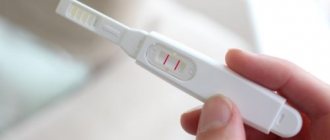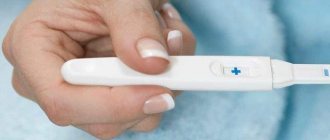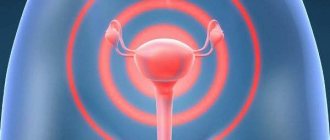Pregnancy test - when to do it?
It is known that any rapid pregnancy tests are based on detecting a hormone called human chorionic gonadotropin (hCG) in the urine. It begins to be produced by the future placenta (chorion) almost immediately after fertilization and every day its concentration increases several times. Therefore, such pregnancy tests can be carried out even during menstruation, the main thing is to strictly follow the instructions.
And you shouldn’t be surprised if all the symptoms indicate pregnancy, and your periods come on time for some time. Such cases occur quite often in medical practice, although they are not considered the norm. They are most often explained by hormonal disorders that provoke minor bleeding that occurs at periods approximately coinciding with the periods of normal menstruation.
Regular cycle tests
A regular cycle means that you always have the same number of days of your period and a break in between. That is, from the beginning of menstruation to the beginning of subsequent periods, 22-30 days pass. With a stable menstrual cycle, the egg is released in the middle of the cycle. If your menstrual cycle is 30 days, then you will ovulate on the 15th day. With a 28-day cycle, ovulation normally occurs on the 14th day.
Within two days after the release of the egg, the probability of pregnancy is highest. If conception occurs during this period, then the fertilized egg takes 4-5 days to reach the uterus, where an anchorage will be formed. This means that a blood test will show an increase in hCG only on the 22nd day of the cycle.
The best pregnancy tests can show you a positive result 4 days before your period. At this time, the level of human chorionic gonadotropin exceeds 25 mUI. A highly sensitive pregnancy test can be done on the 26th day of the monthly cycle if the total number of days in the cycle is 30. If the cycle is 28 days, then the test can be done on the 24th day.
Rules for conducting a pregnancy test
To count on the most accurate result, you must be especially careful in following the instructions when performing a pregnancy test. And the absence of menstruation or its regularity should not affect the implementation of these rules. So, the necessary conditions for carrying out the analysis:
- Since the “pregnancy hormone” (hCG) has the highest concentration in morning urine, it is most advisable to carry out the test at this time of day. Of course, if the situation requires urgent action, this procedure can be done at any other time;
In order to prevent the result from being “blurred”, it is better to refrain from excessive fluid intake on the eve of the procedure;
It is not necessary to achieve absolute sterility of the urine collection container, the main thing is that it is clean and grease-free;
To carry out the analysis, 20-30 ml of urine is enough. The test strip must be placed in it to the level marked on it and urine for 20 seconds. After this, remove and place on a horizontal surface. Results can be expected in 2 minutes and should not be delayed, because after 5 minutes the strip may show incorrect data.
There are many types of tests to determine pregnancy and the reliability of their results can vary significantly. Thus, the most accurate indicators are provided by jet tests, for which, by the way, there is no need to arm yourself with a glass of collected urine.
What to do to get the most accurate result?
As you can see, there are many factors influencing the results of a home pregnancy test. Let us give you some simple rules that will help you avoid some mistakes and misconceptions:
- If you experience a delay in your next menstruation, do not rush to attribute it to stress, weather changes, exacerbation of chronic diseases, etc. At the same time, remember that a delay does not always mean pregnancy. First of all, take a pregnancy test, since pregnancy can occur during sexual activity, regardless of whether contraception was used or not. A delay in the next menstruation, especially if it lasts more than 5-7 days, is a direct indication for conducting a pregnancy test at home.
- When purchasing a test, make sure that it is not expired, the packaging is sealed (that is, the conditions for storing and transporting the test were not violated), and there are detailed instructions for use and interpretation of the test results.
- Before starting the test, carefully read the instructions for use and prepare everything you need to carry out the test. When conducting the test, it is necessary to strictly follow even the minor details indicated in the instructions, since failure to comply with them can distort the result. After the test, you will have 5-10 minutes to read the instructions again and make sure that everything was done correctly. In due time, begin interpreting the test result, following the instructions.
- If you think that the test was performed early, the instructions were not followed, the test is defective, etc., or you have the slightest doubt about the reliability of the result, re-test after 2-3 days (especially if menstruation has not occurred).
- If necessary, use additional tests to diagnose pregnancy: measuring basal temperature, blood and urine tests for hCG, ultrasound of the pelvic organs, etc.
- Regardless of the test results, be sure to visit a gynecologist!
What do the mysterious stripes mean?
Having carried out an analysis to determine pregnancy, the next step is to interpret its results. What do the stripes that appear on the test strip indicate?
- Two stripes are clearly visible - congratulations, you are pregnant! The test is positive;
One line appears - the test is negative. There is no pregnancy;
One strip is faintly visible - the result is ambiguous and requires rechecking.
If the pregnancy test gives a 100% positive result and menstruation does not stop, you should consult a doctor as soon as possible to rule out a miscarriage or ectopic pregnancy.
Does it always show true results?
Unfortunately, even the most expensive tests tested by thousands of consumers can show false results.
The reason is not the quality of the product, but the state of the woman’s body. It is worth noting that the wrong result occurs only in five percent of cases, and some of them appear when using a stitched test. But in other cases, there is reason to think about your health or, at least, about observing the rules of personal hygiene.
If a woman does not wash well before using the test, the urine may become contaminated. As a result, the result will be incorrect. In addition, hCG is not always produced only in cases where pregnancy is relevant.
If a girl has recently suffered a miscarriage or abortion, her hormonal levels may not yet have returned to normal, and the result will be false. The same applies to situations when the patient takes hormonal drugs, including contraceptives (paradox - she takes pills for pregnancy, but the test result is positive).
Important! Sometimes pregnancy tests show a false result in cases of serious illness. More details below.
Menstruation during pregnancy - how dangerous are they?
Bleeding during pregnancy can have several causes. The least dangerous is discharge in the first months of gestation. This may be a kind of “memory” of the body about regular periods. But you still need to be careful about this, since such regular discharge can also provoke a miscarriage.
An ectopic pregnancy is also possible, but in this case, spotting is usually accompanied by pain in the lower abdomen. In the second half of pregnancy, bleeding is especially dangerous, as it may indicate placental abruption. And this threatens not only the loss of the mother’s blood, but also the death of the child. Therefore, any uncharacteristic discharge in a pregnant woman should be a reason to immediately call an ambulance.
Every adult girl must know that pregnancy and menstruation are mutually exclusive concepts. But sometimes doubt arises. The question of whether it is possible to take a pregnancy test during menstruation interests many women of reproductive age. It is impossible to prohibit a woman from conducting home testing at any phase of her cycle. In addition, such a study has no contraindications. However, the decisive factor in this process is compliance with the rules and the correct interpretation of the results obtained.
Following the theory, there is no point in taking a pregnancy test during menstruation. The menstrual cycle is divided into three phases:
- (active growth and maturation of follicles occurs);
- ovulatory (the dominant follicle that releases the egg is determined);
- (a corpus luteum forms in place of the follicular sac).
Further, in the absence of pregnancy, menstruation begins - the rejection of the endometrium, which was grown to attach the fertilized egg. If conception has occurred, then menstruation does not come on the prescribed day. The fertilized egg is attached to the wall of the reproductive organ and uses the endometrium as a nutrient medium, in much the same way as a plant feeds from the soil. The corpus luteum, functioning at the site of the burst follicle, secretes progesterone, which supports the process of development of new life.
It is logical to say that a pregnancy test during menstruation will show a negative result. After all, if bleeding began, then conception did not take place. Despite the rule, there are always exceptions. It happens that before the delay, a positive test was received and menstruation began as usual. Or menstrual bleeding has ended, and the strip strip shows a positive response. Of course, in any doubtful situation you should contact a gynecologist or do an ultrasound on your own initiative, but knowing in advance about the causes of this condition will also not be superfluous.
Types of tests
Today, the most accurate and widely used are Evitest and Frautest. They are made in Germany and are affordable. The remaining tests should be considered reliable if you used them correctly and on time. The most accurate results are obtained if you are tested in the first 1-3 days after the delay of critical days. Remember that the low cost of a home pregnancy test is due to the cheap reagents that are used in it.
Strip test
- Evitest №1
- FRAUTEST Express
- Femitest Practical
- Secret
- Femitest Practical Ultra
- BBtest
- Itest Plus
- Eve
These are budget tests, which are a strip on which a layer of antibodies to hCG is applied. If you are pregnant, you will see two lines on the test strip. Instructions: take a clean container and collect 10 or more ml of morning urine into it. Lower the test strip with the correct side to the clearly indicated level and hold for 10 seconds (or other amount of time specified in the instructions).
The result will be visible within 1-10 minutes. If the level of hCG in the urine is just starting to rise, then the second strip will definitely not appear in the first minutes. Remember that any pregnancy tests, especially strip tests, can give false results.
Tablet pregnancy tests
- Evitest Proof
- Frautest Expert
- KnowNow optima
- Sezam
- Clearblue
- Femitest handy
- LadyTest-C
The test is a box with two windows. The kit you purchase will include a pipette and a container for collecting urine. Instructions: drop 4 drops of your urine into the indicated window. The result will appear in the second window after a few minutes (read the exact time on the packaging or in the instructions for the purchased test).
These tests show correct results from the first day of your missed period. It is not rational to use it before the delay, because you will not get reliable results either. The downside of these tests is also that they are more difficult to use than strip pregnancy tests, which we wrote about just above.
Inkjet tests
- Clearblue
- Femitest jet ultra
- Frautest comfort
- Clear view
- FRAUTEST EXCLUSIVE
- Evitest Perfect
- Duet
No urine collection is required for this test. You will need to place it under the stream of urine while going to the toilet “little by little.” Instructions: hold the test under running urine or in a container with urine with the indicated end for 10 seconds. This may be a different immersion time; carefully check your manufacturer's instructions. The result is assessed in 1-10 minutes, and no later. It will be visible in the window. If you are pregnant, the test will show 2 lines.
Manufacturers promise that the test is so sensitive that it can be used 5 days before the expected delay of menstruation. Inkjet tests are considered more accurate and reliable than strip tests for home use. But their main disadvantage is their high cost.
Electronic tests (digital)
- ClearBlue digital
- Test with Pteq USB connector
This is the newest development. Instructions: Dip the test tip into the urine with the indicated tip (where the filter is located) until it is saturated. The result will be visible after 3 minutes. A special window will display the inscription “pregnansy” or a plus sign in case of pregnancy. These tests are considered to indicate pregnancy when there are still 4 days left before the missed period.
Its accuracy is 99% if tested 2 days before the planned critical days. Electronic or digital pregnancy tests are the most sensitive to the “pregnancy hormone”. The result can be seen in the window for about 24 hours, then the inscription is erased, and you will not be able to save the test as a memory. This category of tests is expensive.
The test showed two lines, but menstruation began
If the test is positive, but your period has begun, then the first thing doctors will think about is the threat of interruption. Gynecological statistics show that every third expectant mother experiences this condition at different stages. The reasons for the threat can be very different:
- corpus luteum deficiency;
- formation of detachment and hematoma;
- abdominal trauma;
- disruptions in the functioning of the endocrine system;
- increased nervousness;
- hard physical labor;
- inaccurate gynecological examination;
- "aggressive" sexual intercourse.
In many cases, timely medical intervention and correctly chosen therapy will allow you to maintain the pregnancy so that the next menstruation begins only after childbirth.
Another reason that the test was positive and menstruation began a few days later is the incorrect use of the strip strip. In fact, there was no pregnancy, but the test was wrong. A false positive result occurs in some gynecological and systemic diseases.
Also, the cause of this condition can be a biochemical pregnancy that is interrupted before the delay. That is, fertilization of the egg took place, but it did not attach to the wall of the uterus.
Another option is an ectopic pregnancy. Attachment of the fertilized egg in an unintended place is manifested by the fact that a positive pregnancy test is accompanied by vaginal bleeding.
Negative tests
Many people are concerned about whether tests for home use can show a false negative result, and when there is such a possibility. The level of human chorionic gonadotropin (which is released when a fertilized egg attaches to the uterus) increases at different rates for everyone.
For some, 2 weeks pass from the day of the delay, and the test shows a negative result. This happens if there is a threat of miscarriage, or the expectant mother has endocrine gland dysfunction. If you use the test immediately after unprotected sexual intercourse, you will also receive a negative result. Firstly, conception may not have happened yet. Secondly, to obtain reliable results, several days must pass from the moment of conception.
A negative pregnancy test result can be obtained if it is used incorrectly:
- put it down the wrong way
- collect urine in the evening or morning
- apply an expired test, etc.
The test may also show a positive result if there has been no conception. This result is called a false positive . Causes:
- ovarian dysfunction
- period 2 months after birth
- overdue test
- growth in a woman’s body of a tumor that produces hormones (hydatidiform mole, chorionic carcinoma)
Two stripes after menstruation
After menstruation, a test can be positive for two reasons:
- we are talking about bleeding that is not related to menstruation;
- A hormonal imbalance occurred, resulting in two ovulations.
If the study is carried out immediately after the end of bleeding, and the test shows two stripes, then the cause of this condition may be a hormonal imbalance. The test may mistake some other hormones for the hCG hormone if they are present in the urine in high concentrations.
In rare cases, a woman may experience two ovulations in one cycle. In this case, the egg will be released at different times. One follicle ovulates at the prescribed time, and the second only before menstruation. With unprotected sex, conception will occur, as a result of which the woman will receive a positive test a few days after the end of bleeding.
Many women mistake bleeding of a different origin for menstruation. For example, there is pregnancy, and bleeding is caused by erosion or injury to the cervix. Often this bleeding occurs after sexual intercourse. It turns out that conception has occurred, and the test will soon show a positive result, and the woman believes that she is now having her period.
The cause of short bleeding may be implantation of the embryo into the uterine cavity. If a woman tests at home just 3-5 days after menstruation, and the bleeding was short and not heavy, and the test shows 2 stripes, implantation has probably taken place. When the fertilized egg implants into the wall of the reproductive organ, minor damage to the blood vessels occurs. Discharge of blood for 1-3 days is considered normal, but many women mistake it for another menstruation. Patients tell the doctor that they had a positive test after their period.
Signs and symptoms at 2 weeks pregnant
If we talk about the second obstetric week, then there can be no signs of pregnancy, since in fact, conception has not yet occurred. A woman may experience some symptoms characteristic of ovulation: slight pulling or stabbing sensations in the area of the left/right ovary, increased libido, copious discharge, the consistency of which resembles egg white.
It is these signs in the middle of the cycle that may indicate that the follicle has ruptured and the egg is ready for fertilization. This period is the most favorable for the birth of a new life, and if everything goes well, the egg will be fertilized.
How to increase your chances of getting pregnant?
During sexual intercourse, sperm enter an environment that is foreign to them. In order for at least one of them to survive and fulfill his “mission,” he needs help. Gynecologists note that the position in which a couple makes love is of great importance. They recommend the "missionary position" or knee-elbow position (the man is behind the woman).
After the end of sexual intercourse, to increase the chances of success, it is better for a woman to lie down for 20-30 minutes. You can place a small pillow under the pelvic area. This will facilitate the movement of sperm to the egg.
Signs of pregnancy 2 weeks from conception
The 2nd week from conception is the 4th obstetric week. Some women at this stage already feel that they will soon become mothers. The majority do not show any changes, and tests show only a negative result. Even an ultrasound specialist can detect pregnancy at such an early stage in very rare cases. But do not be upset, because if pregnancy has occurred, then the first signs will not keep you waiting. Within 1-2 weeks your baby will make his presence known. Read more about all possible symptoms of pregnancy in the 2nd week from conception here.
Is there any point in doing a test?
To answer the question whether it is possible to do a pregnancy test during menstruation in one case or another, you need to understand the operating principle of this mini-device. Despite the different price categories, different types and different methods of use, the mechanism of operation of all devices is the same. The main goal is to identify the pregnancy hormone – human chorionic gonadotropin. Most strip strips, inkjet and tablet devices have a hidden reagent on their surface.
Upon contact with the urine of the expectant mother, it appears, and the woman sees that the test showed 2 stripes. It should be noted that the concentration of human chorionic gonadotropin in the blood is much higher than in the urine. Therefore, if there is a suspicion of pregnancy during menstruation, a blood test for hCG should be done. The reliability of this analysis is very high.
The question of whether the test will show pregnancy during menstruation can be answered in the affirmative. But only with a caveat: in fact, this is not menstruation, but bleeding of a completely different nature. If conception occurred 10-14 days ago or earlier, then a home study carried out in accordance with the instructions will show a true positive result. Bleeding will not affect it.
It is important to perform the diagnosis correctly. To prevent menstrual fluid from getting into the container with urine, you need to thoroughly wash yourself before collecting the material and insert a tampon into the vagina.
The causes of bleeding with a positive result can be harmless physiological (for example, embryo implantation) and pathological (risk of miscarriage).
A medical examination will help you reliably understand what is happening and take action if necessary.
When and how to test correctly
There are certain rules that must be followed when conducting the test. But women still ask questions.
Namely:
- performing the test before or after the expected delay of menstruation;
- performing the test with an irregular or regular cycle;
- test execution time.
Usage rules apply to all tests:
- Wash thoroughly.
- Wipe off all liquid with a towel.
- Collect the biomaterial in a container (if necessary) and lower the device into it or place the test under a stream of urine.
- Wait for the result.
Before the delay
Tests with high sensitivity can show results before a missed period. This period is approximately 3 weeks from the end of menstruation. Fertilization has already occurred, the level of the hormone can affect the ultra-sensitive test. That is, it is allowed to use the device until the delay.
Domestic tests cannot show the correct result before the expected delay. And the electronic form (Clearblue) is allowed to be used. But the accuracy of the result depends on the day of application. For example, if you use the Clearblue test 4 days before the expected menstruation, then the probability of a correct result is 55%, and 2 days before - 97%.
After a delay
It is allowed to perform the test from the first day of missed menstruation. But manufacturers recommend using the device after 7 days of delay. This way you can achieve the most accurate result.
With a regular menstrual cycle
With a regular cycle lasting 28 days, ovulation occurs in the middle (day 14). Upon contact with a sexual partner without the use of contraceptives, fertilization can occur, but attachment to the uterine cavity takes 7 days. HCG levels rise on day 22 of the menstrual cycle. Therefore, the test is allowed from the first day of the delay.
With an irregular menstrual cycle
Some women have irregular periods. That is, discharge may be delayed or come ahead of time. It is difficult to predict the likelihood of conception; the date of ovulation is unknown. The release of the egg is possible at any time.
Women who want to get pregnant use various methods to track ovulation - fever, tests (sold in pharmacies).
When ovulation is known, the product can be used after 2 weeks . If a woman cannot determine the exact day, the test can be performed no earlier than 10 days from the first day of absence of menstruation.
What time of day should I do it?
Many sources indicate that it is better to carry out the test in the morning. This often applies to regular strips. If conception has occurred recently, an inexpensive test is used, then it is better to collect urine in the morning. This can improve accuracy. If the delay is more than 10 days or using a highly sensitive test (Cliablue), there is no difference when to carry out the manipulation.
Dangerous situations
Sometimes the fact that the test showed pregnancy, but at the same time you are menstruating, is a very ominous symptom.
Spontaneous abortion
The situation when bleeding begins after a positive test is quite common. For most expectant mothers, this occurs early, before 12 weeks. A pregnancy test during menstruation can be done in this case to make sure that it has not been missed. If a woman notices that the test strip is becoming paler, then a miscarriage has probably begun and nothing can be corrected. Additional symptoms of threatened termination are nagging pain in the lower abdomen and lower back.
Ectopic pregnancy
Is it possible to do a test during menstruation to detect an ectopic pregnancy? It is possible, but a diagnosis cannot be made using the test. Attachment of the fertilized egg outside the uterine cavity may be accompanied by bleeding, and the strip strip shows two lines. Additional signs of an ectopic pregnancy are acute abdominal pain, weakness, drop in blood pressure and lightheadedness.
In both cases, when bleeding begins after a positive test result, the woman needs medical attention. Otherwise, there will be a threat to her reproductive health and even life.
The question of whether it is possible to take a pregnancy test during menstruation can be answered positively with confidence. Bleeding does not affect the test result. If a positive test result is accompanied by bleeding or menstruation began a few days after receiving two strips, then you need to urgently contact a gynecologist.
Most women know that every month, around the middle of the cycle, there are days when conception is most likely. Some are waiting for them with caution, others with hope. Most women are sure that if their periods come on time, there is no delay, which means there is no pregnancy.
Someone sighs with relief and puts a new mark on the calendar for the beginning of the next cycle. Someone, on the contrary, is upset because the desired pregnancy did not happen. But in nature, events do not always develop the way you are used to.
Features of the female cycle
A woman’s cycle is the interval from the first day of her period to the next moment of its onset. Its average duration is one lunar month or 28 days. But this is on average. In practice, there can be both very short, 21 days, and longer, up to 37 days, cycles.
Any cycle can be divided into two phases, the first of which ends with ovulation, which lasts about a day or two. The second, which begins after it, is the actual menstrual bleeding, the duration of which can vary from three to seven days.
Everything is regulated by two hormones: follicle-stimulating and luteinizing hormones, which are produced by the pituitary gland. The cycle itself is divided into three main phases:
- The follicular or menstrual phase begins on the first day of the cycle, that is, from the moment the next menstruation begins and continues approximately until its middle. During this time, under the influence of the hormone that actually gives this phase its name, one of the follicles matures in the ovaries, which becomes dominant and in the future will give rise to a new egg.
- The ovulatory phase begins with the rupture of the membrane of the dominant follicle and the release of an egg ready for fertilization. This phase can last from 12 hours to two days.
- Luteal is the third and final phase of the cycle, controlled by luteinizing hormone. It begins after ovulation, with the formation of the corpus luteum in the body - a temporary endocrine gland that produces hormones designed to maintain pregnancy. Of course, if conception occurred in the second phase of the cycle. If this does not happen, then the corpus luteum simply stops working. The decreasing level of hormones, mainly progesterone, leads to the rejection of the uterine mucosa, menstruation begins and a new cycle begins.
When pregnancy occurs, the corpus luteum remains until the placenta is formed, which takes over its function. Hormone levels rise and menstruation does not occur.
How does a pregnancy test work?
However, events do not always develop according to this scenario. There are cases when the expected delay in pregnancy does not occur, menstruation came strictly on schedule, and the pregnancy test shows a positive result. Although it seems that this is impossible. To understand the reason for this, you first need to figure out what exactly it reacts to.
Approximately on the fifth to seventh day from the moment of fertilization, the egg enters the uterus, where it attaches to one of its walls. The outer shell that has formed by this time, the chorion, has many blood vessels and not only provides adequate nutrition to the fetus, but also produces a special hormone designed to maintain pregnancy.
It is the presence of this hormone, which gets its name from the shell, that determines the pregnancy test.
If the test is positive
Normally, human chorionic gonadotropin is not formed in the body of a non-pregnant woman, and the most sensitive test can detect it at a minimum concentration in the urine of 25 mU/ml. However, it happens that your period came on time, and after it the test unexpectedly showed two stripes. This happens in two cases:
- If pregnancy does occur, but your period comes exactly on time.
- If there is no pregnancy, your period has started, but the test determines the presence of gonadotropin in the urine.
In addition to confirming pregnancy, gonadotropin serves as an indicator of its normal course and helps to identify various abnormalities.
That is why the hCG test is one of the main ones and is taken throughout the entire period of gestation.
When to see a doctor?
Some terrible diseases greatly affect hormonal levels, including increasing the concentration of hCG.
Such pathologies include a variety of cysts and cancerous tumors. Moreover, they are usually not benign, although there are exceptions. Cancer does not necessarily affect the genitourinary system; cancer in any case affects hormones, so the examination by a doctor should be comprehensive.
Another situation, which is somewhat milder, is a cyst of the stomach or ovaries. In both cases, detailed examination and treatment are required.
A pregnancy test has long been a lifesaver for those women who want to quickly and accurately find out about the fact of their pregnancy, or vice versa - to refute assumptions.
The main varieties provide very high accuracy, they are convenient to use, but sometimes they can give false results. In some cases, this is a sign of a dangerous disease, so if you are definitely not pregnant, but the test shows two lines, then go to the doctor immediately!
Menstruation during pregnancy
Quite often, the signs of pregnancy in the early stages are similar in PMS. A woman experiences nausea in the morning, which she blames on diet errors. He suffers from insomnia and irritability, which he blames on his cycle, hormones, or troubles at work.
But her period came on time, without delays, and this makes her finally convinced that there is no pregnancy. However, this is not always the case.
Causes
Menstruation in the early stages of pregnancy is a rare phenomenon, but still occurs. Their presence does not always indicate the development of pathology; quite often, menstruation is a type of normal. There may be several such situations.
An egg that has not had time to implant
It happens that the fertilized egg does not have time to leave the fallopian tube and becomes fixed in the uterine cavity. In this case, it does not provoke the production of hormones aimed at preserving the embryo.
The body does not yet know about the pregnancy and events develop according to the usual scenario. The mucous layer of the uterus becomes thinner, dries out and is rejected, and menstruation occurs without delay. All this time, the embryo is in the cavity of the tube, and then it is fixed on the new endometrial layer.
This happens especially often with a short cycle of 21 days.
Double ovulation
Two eggs mature in the body simultaneously or with a break of several days. One of them is fertilized, and the one that is unlucky comes out along with the next menstruation, which also comes without delay.
According to statistics, such a repeated surge of hormones, provoking the maturation of another egg, occurs in approximately 10% of women. The nature of this phenomenon has not yet been sufficiently studied; scientists have not been able to find out exactly what exactly can trigger the maturation of two eggs at once. It is believed that stressful situations, irregular sex life and even certain foods are responsible for this.
Implantation bleeding
This bleeding, which occurs after the egg attaches to the endometrium of the uterus, is quite often confused with menstruation, especially if it is prolonged and begins on the usual day.
When the embryo attaches to the wall of the uterus, damage occurs to the vessels with which it is quite densely penetrated. Implantation bleeding occurs approximately 10–14 days after conception.
If your cycle is 28 days, then it is quite easy to confuse it with the onset of menstruation.
Other reasons
In both situations, the expected delay in menstruation will most likely occur in the second month of pregnancy. However, sometimes this does not happen either. The reasons that menstrual bleeding occurs in the second and even third month may be:
- Hormonal imbalances, especially those associated with insufficient progesterone production.
- Hyperandrogenism, in which the body begins to produce the male sex hormone – androgen.
- Attachment of the egg in an unfavorable place.
- Inflammatory or infectious diseases.
- Death of one of the embryos in case of multiple pregnancy.
- Uterine fibroids.
- A frozen or ectopic pregnancy that also tests positive.
What should be done?
If your period comes in the first month of pregnancy, then this is not a reason to panic. This type of bleeding usually:
- Has a weak character.
- Pink or brown discharge.
- It does not get worse over time, but, on the contrary, goes away within a day or two at most.
Most likely, it is associated with egg implantation. However, even this should not be ignored.
Any bleeding that occurs during pregnancy, especially if it occurs in the second or third month, requires immediate medical attention.
Also dangerous are bleeding at any stage, accompanied by pain, dizziness, pallor, a drop in blood pressure and rapid heartbeat.
Positive result after menstruation
However, it happens that there is no pregnancy, the period came on time, but after it the test unexpectedly showed two stripes. That is, human chorionic gonadotropin is present in the body, and in quite large quantities.
Causes
If you do not take into account the low quality of the test, defects, expired expiration dates or improper storage, there may be several reasons for the presence of the hormone in the body:
- The urine sample contained intimate soap or cream, to which the dye substance reacted.
- Erroneous use instead of urine, saliva or blood, which may also contain their own hormones that can cause a test reaction.
- Pregnancy interrupted naturally, most often due to hormonal imbalances in the early stages. The likelihood of such an event remains until 12 weeks, while a delay in menstruation may not occur, and the test result will be positive.
- HCG drugs, which are prescribed to stimulate ovulation or to maintain the function of the corpus luteum of the ovaries.
- Tumor diseases of the ovaries or uterus.
However, in order to exclude the first two reasons for false-positive results, it is enough to use sterile containers for collecting urine or a jet test for analysis. It is better to carry out the analysis in the morning, when the concentration of the hormone in the urine will be higher.
What should be done?
If you purchased a high-quality, accurate test, used it correctly, but are sure that it showed an erroneous result, you can repeat the test in two or three days. But in any case, you should not completely rely on home express methods. Regardless of the result, visit your doctor and undergo a full examination.
Only a specialist will be able to accurately determine the cause of the production of human chorionic gonadotropin in the absence of pregnancy and prescribe appropriate treatment.
The female body is individual and often unpredictable, especially during pregnancy. Hormones are responsible for many processes in it, the production of which can be influenced even by changing moods and bad weather outside the window. Therefore, in case of any troubles or changes in your condition, do not delay visiting a specialist.
If there are no reasons for concern, it won’t hurt anyone to make sure of this once again. If trouble does happen, the sooner the doctor notices it, the greater the chance of minimizing its consequences.
In the early stages of pregnancy, a woman may experience spotting. Therefore, even if your test is positive and your period has arrived, pregnancy should not be ruled out. Is this situation dangerous, what needs to be done and how to protect the baby?
Can I get my period during pregnancy?
Despite the rapid development of technology and healthcare, humanity still cannot fully explain the processes occurring in a woman’s body during pregnancy. Even now it is almost impossible to predict how pregnancy will proceed, because this process is individual for each woman. Sometimes the development of pregnancy can be so unusual that only specialists can recognize the birth of a new life.
First signs of pregnancy:
- toxicosis;
- sudden mood changes;
- irritability.
If these signs appear, you should do a special test, and it is best to consult a doctor.
The most reliable evidence of pregnancy is a special test and the cessation of menstruation, but sometimes these two signs can contradict each other.
Why do periods come during pregnancy? Immediately after the development of the embryo begins in the uterus, the woman’s body produces a special complex of hormones. In particular, the amount of progesterone produced greatly increases; this hormone regulates the growth of the inner uterine lining and practically paralyzes the muscles of the uterus to eliminate the possibility of accidental rejection of the fetus.
Menstruation is a process in which the old egg is excreted from the body along with part of the inner lining of the uterus, therefore, with increased progesterone levels, menstruation is almost impossible.
If the test is positive and your period has arrived, then most often there is no reason to worry about the child’s health. Menstruation can come 5-14 days after conception, and there is nothing strange about this. The fact is that until the fertilized egg reaches the uterus, all processes in the woman’s body occur as usual, and the movement of the embryo can take up to two weeks. Therefore, if conception occurred in the middle of the menstrual cycle, then in the first month of pregnancy a delay in menstruation may not be observed. But if menstruation does not stop for two months, then it is necessary to consult a doctor as soon as possible, since the consequences can be unpredictable.
Reasons for continuing menstruation during pregnancy
Possible reasons for the absence of a delay during pregnancy may be the following:
- ectopic pregnancy;
- hormonal disbalance;
- superovulation;
- hyperandrogenism;
- genetic abnormalities;
- frozen pregnancy.
It is extremely important to recognize an ectopic pregnancy in the first stages of embryo development, because such a situation is dangerous not only for the child, but also for the mother herself. Only specialists can diagnose an ectopic pregnancy, so if there is no delay, it is recommended to consult a doctor immediately.
This category also includes a rather rare phenomenon in which a fertilized egg is implanted in an unfavorable part of the uterus. In this case, there is a high probability of fetal rejection already in the first stages of development, because the embryo cannot receive enough elements necessary for life.
From the moment of conception, a woman’s body undergoes a strong change in the set of hormones produced. If during, then the cause of this may be a violation in the set of hormones. Hormonal imbalances can manifest themselves in different ways during pregnancy. The most common deviation of this type is an insufficient amount of the hormone progesterone.
Unfortunately, the correct hormonal balance during pregnancy in the modern world is organized less and less, which is why a fairly large number of women face this problem. Today, most hormonal imbalances can be easily corrected with the help of special medications.
Most women's bodies produce only one egg per menstrual cycle. But during superovulation, more than one egg is produced, most often two. In this case, the absence of a delay is not a bad sign, because the fertilized egg develops quietly in the woman’s body, and during menstruation, another female gamete is released, which was formed in parallel. It is worth noting that superovulation does not occur very often.
Hyperandrogenism is a special case of hormonal disorders, but most often it is classified as a separate type due to its prevalence. The phenomenon gets its name from the name of the male hormone androgen. A woman’s body contains a small amount of this substance, and with hyperandrogenism its amount significantly exceeds the norm, which can cause cessation of fetal development or rejection of the embryo. A specialist who has identified this problem usually prescribes medications to the girl to control the level of androgen in the body.
Genetic abnormalities are a problem that many pregnant women face. Deviations of this type can greatly affect the development of the fetus, so a patient with this diagnosis should be under the supervision of specialists for all 9 months.
During a so-called frozen pregnancy, a woman should also be under the supervision of qualified doctors. In most cases, this deviation can be corrected, for which the patient must undergo a course of special therapy.
There are also other reasons for continued menstruation during pregnancy. But doctors do not classify them as a number of serious abnormalities that can harm the mother or child. To protect your unborn child as much as possible from all sorts of dangers, it is best to visit a doctor regularly. To reduce the risk of termination of pregnancy or the development of congenital defects in the fetus, doctors recommend undergoing examination before conception.
One of the most unpleasant consequences in the absence of a delay is that the woman may not even know that she is pregnant. In this case, there are no special disturbances in the menstrual cycle, and girls may not think about purchasing a special test. When menstruation occurs during pregnancy, the fetus can suffer greatly.
What should you pay attention to during menstruation during pregnancy?
If you notice a continuation of the menstrual cycle, you should immediately consult a doctor. It is best to start regularly visiting a specialist after pregnancy is detected. According to statistics, the vast majority of pregnant women who turn to specialists in the first trimester of fetal development carry a full-fledged child without any particular difficulties.
You need to understand that the continuation of menstruation during fetal development is almost always a clear sign of some kind of anomaly, albeit minor, and can lead to unpredictable consequences.
Any discharge may also indicate the initial stage of embryo rejection. If a woman underwent a special examination before conception, then when her period begins, there is no need to panic. Most likely, doctors have already foreseen possible scenarios and know what to do in this case.
In medical practice, there are many cases where menstruation occurred throughout the entire development of the fetus, so you should not be afraid of this phenomenon. Qualified doctors have the most modern technologies, thanks to which it is possible to cure almost all abnormalities associated with discharge during pregnancy.









